Dining Behaviors: In-Home, Local Community, and Travel Report Analysis
VerifiedAdded on 2022/09/21
|5
|2426
|20
Report
AI Summary
This report delves into the multifaceted world of dining behaviors, examining the differences in consumer choices across various settings, including in-home dining, local community restaurants, and dining while traveling. The research considers foodservice theory as a framework to understand these behaviors. The study explores the evolution of dining patterns and how factors such as convenience, cost, and individual preferences influence food selection and consumption. The report highlights that in-home dining is often constrained by personal resources, local community dining offers a wider range of choices, and dining while traveling presents unique challenges. The report also emphasizes the importance of service, loyalty programs, and the impact of cultural differences on dining experiences. The research suggests that the patterns of human behavior vary depending on the dining venue, and these differences present opportunities to develop a comprehensive theory of dining. The research also examines the study limitations and proposes future research directions in this area.
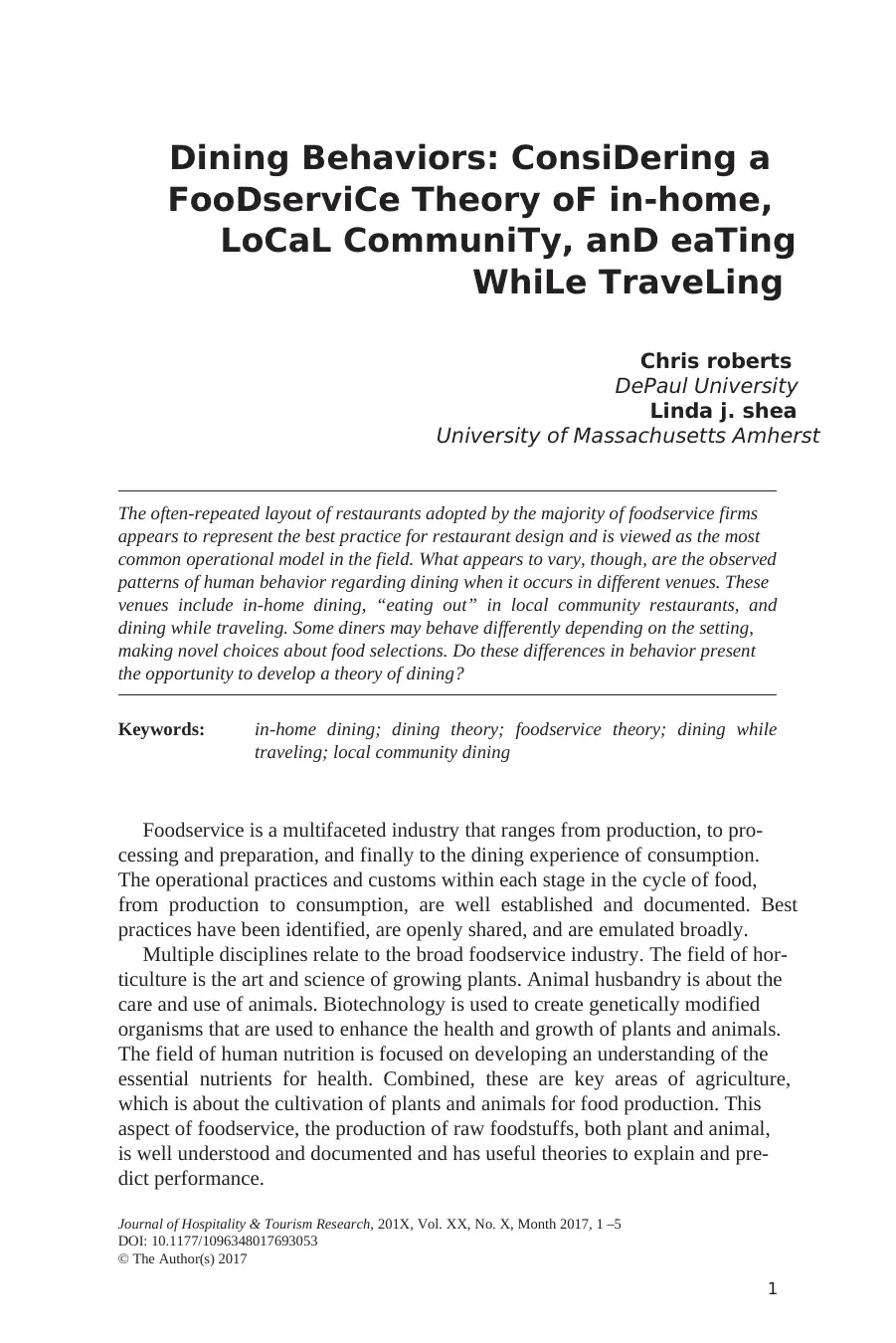
Journal of Hospitality & Tourism Research, 201X, Vol. XX, No. X, Month 2017, 1 –5
DOI: 10.1177/1096348017693053
© The Author(s) 2017
1
Dining Behaviors: ConsiDering a
FooDserviCe Theory oF in-home,
LoCaL CommuniTy, anD eaTing
WhiLe TraveLing
Chris roberts
DePaul University
Linda j. shea
University of Massachusetts Amherst
The often-repeated layout of restaurants adopted by the majority of foodservice firms
appears to represent the best practice for restaurant design and is viewed as the most
common operational model in the field. What appears to vary, though, are the observed
patterns of human behavior regarding dining when it occurs in different venues. These
venues include in-home dining, “eating out” in local community restaurants, and
dining while traveling. Some diners may behave differently depending on the setting,
making novel choices about food selections. Do these differences in behavior present
the opportunity to develop a theory of dining?
Keywords: in-home dining; dining theory; foodservice theory; dining while
traveling; local community dining
Foodservice is a multifaceted industry that ranges from production, to pro-
cessing and preparation, and finally to the dining experience of consumption.
The operational practices and customs within each stage in the cycle of food,
from production to consumption, are well established and documented. Best
practices have been identified, are openly shared, and are emulated broadly.
Multiple disciplines relate to the broad foodservice industry. The field of hor-
ticulture is the art and science of growing plants. Animal husbandry is about the
care and use of animals. Biotechnology is used to create genetically modified
organisms that are used to enhance the health and growth of plants and animals.
The field of human nutrition is focused on developing an understanding of the
essential nutrients for health. Combined, these are key areas of agriculture,
which is about the cultivation of plants and animals for food production. This
aspect of foodservice, the production of raw foodstuffs, both plant and animal,
is well understood and documented and has useful theories to explain and pre-
dict performance.
693053 JHTXXX10.1177/1096348017693053JOURNAL OF HOSPITALITY & TOURISM RESEARCH roberts, shea / dINING BeHAVIors
research-article 2017
DOI: 10.1177/1096348017693053
© The Author(s) 2017
1
Dining Behaviors: ConsiDering a
FooDserviCe Theory oF in-home,
LoCaL CommuniTy, anD eaTing
WhiLe TraveLing
Chris roberts
DePaul University
Linda j. shea
University of Massachusetts Amherst
The often-repeated layout of restaurants adopted by the majority of foodservice firms
appears to represent the best practice for restaurant design and is viewed as the most
common operational model in the field. What appears to vary, though, are the observed
patterns of human behavior regarding dining when it occurs in different venues. These
venues include in-home dining, “eating out” in local community restaurants, and
dining while traveling. Some diners may behave differently depending on the setting,
making novel choices about food selections. Do these differences in behavior present
the opportunity to develop a theory of dining?
Keywords: in-home dining; dining theory; foodservice theory; dining while
traveling; local community dining
Foodservice is a multifaceted industry that ranges from production, to pro-
cessing and preparation, and finally to the dining experience of consumption.
The operational practices and customs within each stage in the cycle of food,
from production to consumption, are well established and documented. Best
practices have been identified, are openly shared, and are emulated broadly.
Multiple disciplines relate to the broad foodservice industry. The field of hor-
ticulture is the art and science of growing plants. Animal husbandry is about the
care and use of animals. Biotechnology is used to create genetically modified
organisms that are used to enhance the health and growth of plants and animals.
The field of human nutrition is focused on developing an understanding of the
essential nutrients for health. Combined, these are key areas of agriculture,
which is about the cultivation of plants and animals for food production. This
aspect of foodservice, the production of raw foodstuffs, both plant and animal,
is well understood and documented and has useful theories to explain and pre-
dict performance.
693053 JHTXXX10.1177/1096348017693053JOURNAL OF HOSPITALITY & TOURISM RESEARCH roberts, shea / dINING BeHAVIors
research-article 2017
Paraphrase This Document
Need a fresh take? Get an instant paraphrase of this document with our AI Paraphraser
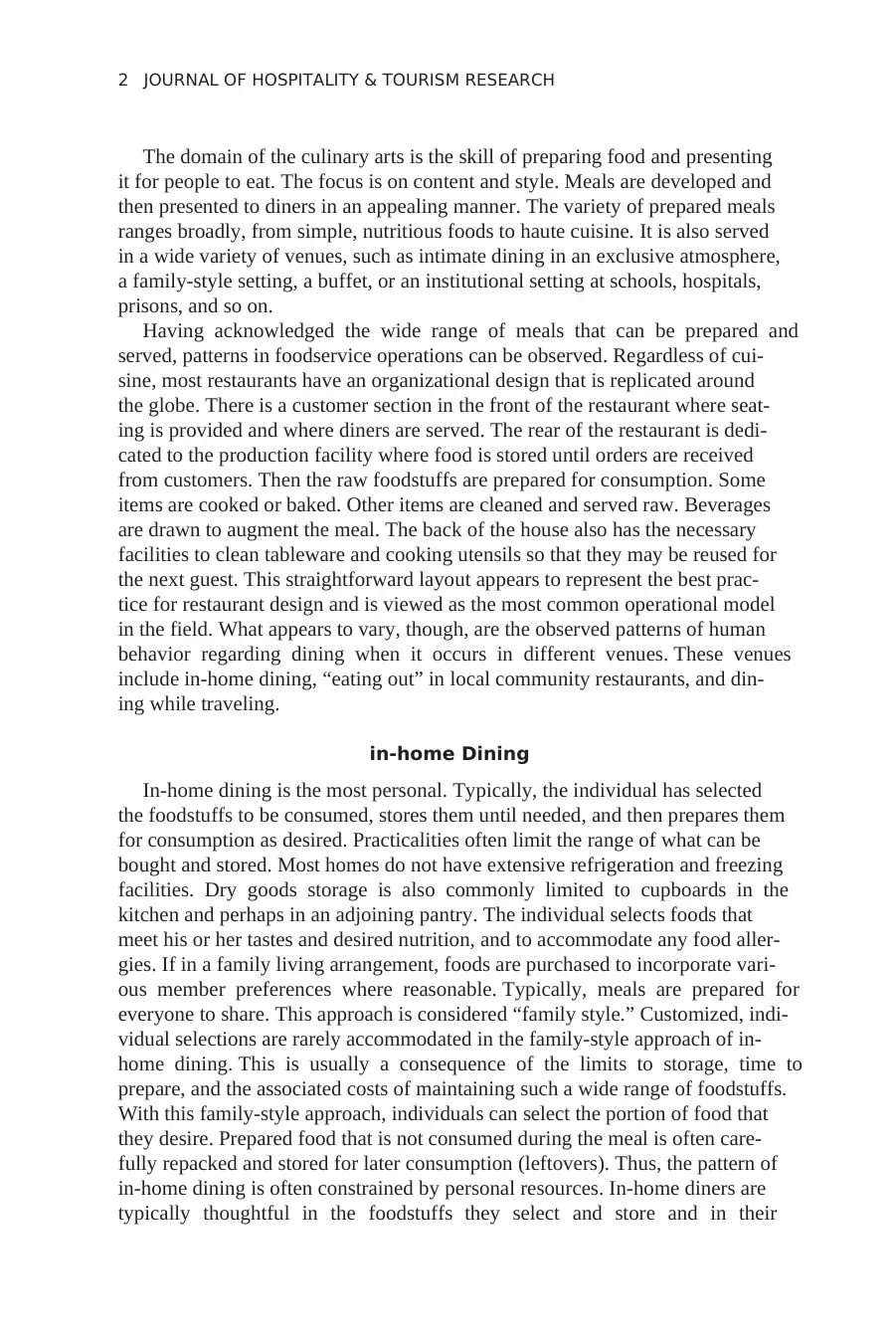
2 JOURNAL OF HOSPITALITY & TOURISM RESEARCH
The domain of the culinary arts is the skill of preparing food and presenting
it for people to eat. The focus is on content and style. Meals are developed and
then presented to diners in an appealing manner. The variety of prepared meals
ranges broadly, from simple, nutritious foods to haute cuisine. It is also served
in a wide variety of venues, such as intimate dining in an exclusive atmosphere,
a family-style setting, a buffet, or an institutional setting at schools, hospitals,
prisons, and so on.
Having acknowledged the wide range of meals that can be prepared and
served, patterns in foodservice operations can be observed. Regardless of cui-
sine, most restaurants have an organizational design that is replicated around
the globe. There is a customer section in the front of the restaurant where seat-
ing is provided and where diners are served. The rear of the restaurant is dedi-
cated to the production facility where food is stored until orders are received
from customers. Then the raw foodstuffs are prepared for consumption. Some
items are cooked or baked. Other items are cleaned and served raw. Beverages
are drawn to augment the meal. The back of the house also has the necessary
facilities to clean tableware and cooking utensils so that they may be reused for
the next guest. This straightforward layout appears to represent the best prac-
tice for restaurant design and is viewed as the most common operational model
in the field. What appears to vary, though, are the observed patterns of human
behavior regarding dining when it occurs in different venues. These venues
include in-home dining, “eating out” in local community restaurants, and din-
ing while traveling.
in-home Dining
In-home dining is the most personal. Typically, the individual has selected
the foodstuffs to be consumed, stores them until needed, and then prepares them
for consumption as desired. Practicalities often limit the range of what can be
bought and stored. Most homes do not have extensive refrigeration and freezing
facilities. Dry goods storage is also commonly limited to cupboards in the
kitchen and perhaps in an adjoining pantry. The individual selects foods that
meet his or her tastes and desired nutrition, and to accommodate any food aller-
gies. If in a family living arrangement, foods are purchased to incorporate vari-
ous member preferences where reasonable. Typically, meals are prepared for
everyone to share. This approach is considered “family style.” Customized, indi-
vidual selections are rarely accommodated in the family-style approach of in-
home dining. This is usually a consequence of the limits to storage, time to
prepare, and the associated costs of maintaining such a wide range of foodstuffs.
With this family-style approach, individuals can select the portion of food that
they desire. Prepared food that is not consumed during the meal is often care-
fully repacked and stored for later consumption (leftovers). Thus, the pattern of
in-home dining is often constrained by personal resources. In-home diners are
typically thoughtful in the foodstuffs they select and store and in their
The domain of the culinary arts is the skill of preparing food and presenting
it for people to eat. The focus is on content and style. Meals are developed and
then presented to diners in an appealing manner. The variety of prepared meals
ranges broadly, from simple, nutritious foods to haute cuisine. It is also served
in a wide variety of venues, such as intimate dining in an exclusive atmosphere,
a family-style setting, a buffet, or an institutional setting at schools, hospitals,
prisons, and so on.
Having acknowledged the wide range of meals that can be prepared and
served, patterns in foodservice operations can be observed. Regardless of cui-
sine, most restaurants have an organizational design that is replicated around
the globe. There is a customer section in the front of the restaurant where seat-
ing is provided and where diners are served. The rear of the restaurant is dedi-
cated to the production facility where food is stored until orders are received
from customers. Then the raw foodstuffs are prepared for consumption. Some
items are cooked or baked. Other items are cleaned and served raw. Beverages
are drawn to augment the meal. The back of the house also has the necessary
facilities to clean tableware and cooking utensils so that they may be reused for
the next guest. This straightforward layout appears to represent the best prac-
tice for restaurant design and is viewed as the most common operational model
in the field. What appears to vary, though, are the observed patterns of human
behavior regarding dining when it occurs in different venues. These venues
include in-home dining, “eating out” in local community restaurants, and din-
ing while traveling.
in-home Dining
In-home dining is the most personal. Typically, the individual has selected
the foodstuffs to be consumed, stores them until needed, and then prepares them
for consumption as desired. Practicalities often limit the range of what can be
bought and stored. Most homes do not have extensive refrigeration and freezing
facilities. Dry goods storage is also commonly limited to cupboards in the
kitchen and perhaps in an adjoining pantry. The individual selects foods that
meet his or her tastes and desired nutrition, and to accommodate any food aller-
gies. If in a family living arrangement, foods are purchased to incorporate vari-
ous member preferences where reasonable. Typically, meals are prepared for
everyone to share. This approach is considered “family style.” Customized, indi-
vidual selections are rarely accommodated in the family-style approach of in-
home dining. This is usually a consequence of the limits to storage, time to
prepare, and the associated costs of maintaining such a wide range of foodstuffs.
With this family-style approach, individuals can select the portion of food that
they desire. Prepared food that is not consumed during the meal is often care-
fully repacked and stored for later consumption (leftovers). Thus, the pattern of
in-home dining is often constrained by personal resources. In-home diners are
typically thoughtful in the foodstuffs they select and store and in their
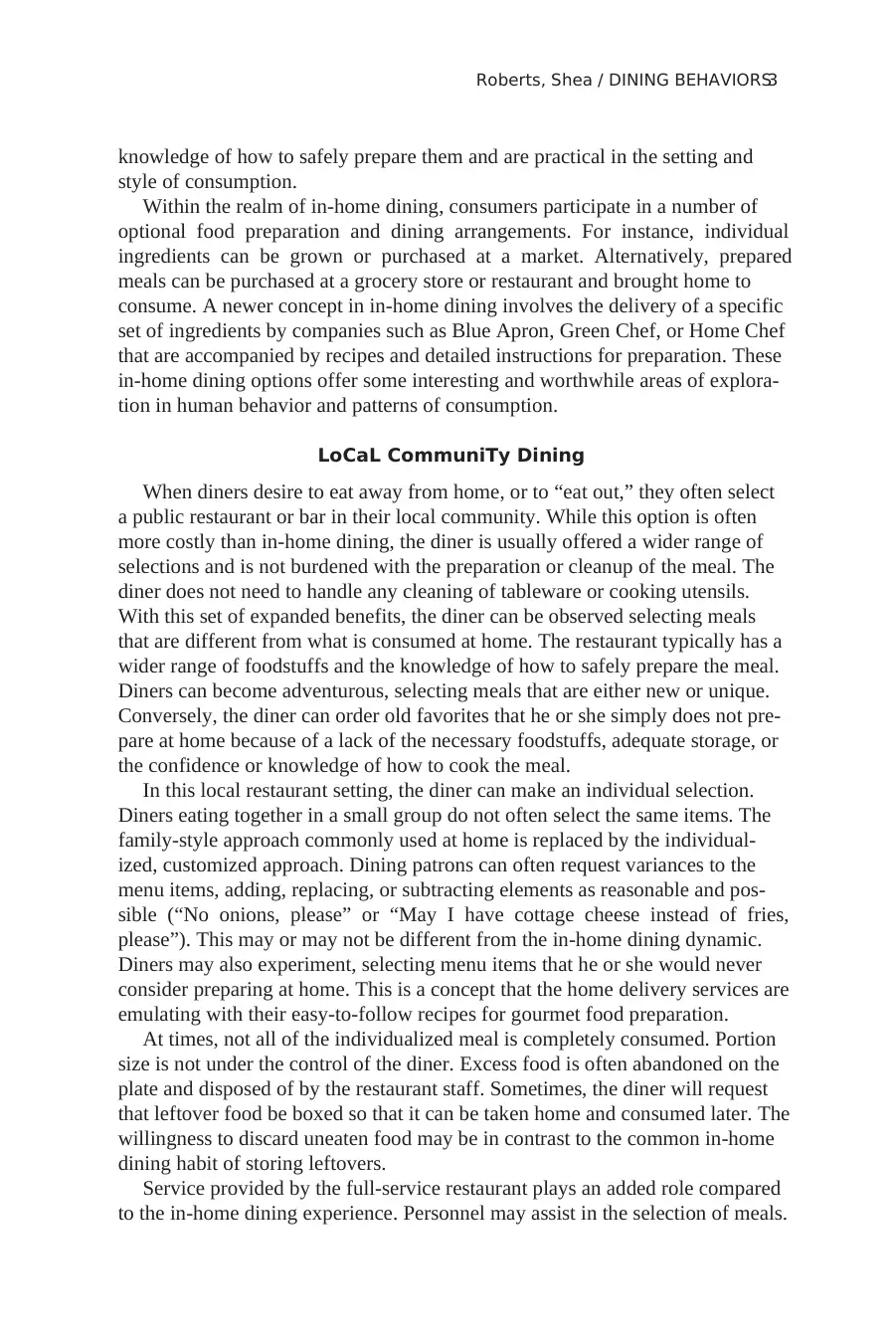
Roberts, Shea / DINING BEHAVIORS3
knowledge of how to safely prepare them and are practical in the setting and
style of consumption.
Within the realm of in-home dining, consumers participate in a number of
optional food preparation and dining arrangements. For instance, individual
ingredients can be grown or purchased at a market. Alternatively, prepared
meals can be purchased at a grocery store or restaurant and brought home to
consume. A newer concept in in-home dining involves the delivery of a specific
set of ingredients by companies such as Blue Apron, Green Chef, or Home Chef
that are accompanied by recipes and detailed instructions for preparation. These
in-home dining options offer some interesting and worthwhile areas of explora-
tion in human behavior and patterns of consumption.
LoCaL CommuniTy Dining
When diners desire to eat away from home, or to “eat out,” they often select
a public restaurant or bar in their local community. While this option is often
more costly than in-home dining, the diner is usually offered a wider range of
selections and is not burdened with the preparation or cleanup of the meal. The
diner does not need to handle any cleaning of tableware or cooking utensils.
With this set of expanded benefits, the diner can be observed selecting meals
that are different from what is consumed at home. The restaurant typically has a
wider range of foodstuffs and the knowledge of how to safely prepare the meal.
Diners can become adventurous, selecting meals that are either new or unique.
Conversely, the diner can order old favorites that he or she simply does not pre-
pare at home because of a lack of the necessary foodstuffs, adequate storage, or
the confidence or knowledge of how to cook the meal.
In this local restaurant setting, the diner can make an individual selection.
Diners eating together in a small group do not often select the same items. The
family-style approach commonly used at home is replaced by the individual-
ized, customized approach. Dining patrons can often request variances to the
menu items, adding, replacing, or subtracting elements as reasonable and pos-
sible (“No onions, please” or “May I have cottage cheese instead of fries,
please”). This may or may not be different from the in-home dining dynamic.
Diners may also experiment, selecting menu items that he or she would never
consider preparing at home. This is a concept that the home delivery services are
emulating with their easy-to-follow recipes for gourmet food preparation.
At times, not all of the individualized meal is completely consumed. Portion
size is not under the control of the diner. Excess food is often abandoned on the
plate and disposed of by the restaurant staff. Sometimes, the diner will request
that leftover food be boxed so that it can be taken home and consumed later. The
willingness to discard uneaten food may be in contrast to the common in-home
dining habit of storing leftovers.
Service provided by the full-service restaurant plays an added role compared
to the in-home dining experience. Personnel may assist in the selection of meals.
knowledge of how to safely prepare them and are practical in the setting and
style of consumption.
Within the realm of in-home dining, consumers participate in a number of
optional food preparation and dining arrangements. For instance, individual
ingredients can be grown or purchased at a market. Alternatively, prepared
meals can be purchased at a grocery store or restaurant and brought home to
consume. A newer concept in in-home dining involves the delivery of a specific
set of ingredients by companies such as Blue Apron, Green Chef, or Home Chef
that are accompanied by recipes and detailed instructions for preparation. These
in-home dining options offer some interesting and worthwhile areas of explora-
tion in human behavior and patterns of consumption.
LoCaL CommuniTy Dining
When diners desire to eat away from home, or to “eat out,” they often select
a public restaurant or bar in their local community. While this option is often
more costly than in-home dining, the diner is usually offered a wider range of
selections and is not burdened with the preparation or cleanup of the meal. The
diner does not need to handle any cleaning of tableware or cooking utensils.
With this set of expanded benefits, the diner can be observed selecting meals
that are different from what is consumed at home. The restaurant typically has a
wider range of foodstuffs and the knowledge of how to safely prepare the meal.
Diners can become adventurous, selecting meals that are either new or unique.
Conversely, the diner can order old favorites that he or she simply does not pre-
pare at home because of a lack of the necessary foodstuffs, adequate storage, or
the confidence or knowledge of how to cook the meal.
In this local restaurant setting, the diner can make an individual selection.
Diners eating together in a small group do not often select the same items. The
family-style approach commonly used at home is replaced by the individual-
ized, customized approach. Dining patrons can often request variances to the
menu items, adding, replacing, or subtracting elements as reasonable and pos-
sible (“No onions, please” or “May I have cottage cheese instead of fries,
please”). This may or may not be different from the in-home dining dynamic.
Diners may also experiment, selecting menu items that he or she would never
consider preparing at home. This is a concept that the home delivery services are
emulating with their easy-to-follow recipes for gourmet food preparation.
At times, not all of the individualized meal is completely consumed. Portion
size is not under the control of the diner. Excess food is often abandoned on the
plate and disposed of by the restaurant staff. Sometimes, the diner will request
that leftover food be boxed so that it can be taken home and consumed later. The
willingness to discard uneaten food may be in contrast to the common in-home
dining habit of storing leftovers.
Service provided by the full-service restaurant plays an added role compared
to the in-home dining experience. Personnel may assist in the selection of meals.
⊘ This is a preview!⊘
Do you want full access?
Subscribe today to unlock all pages.

Trusted by 1+ million students worldwide
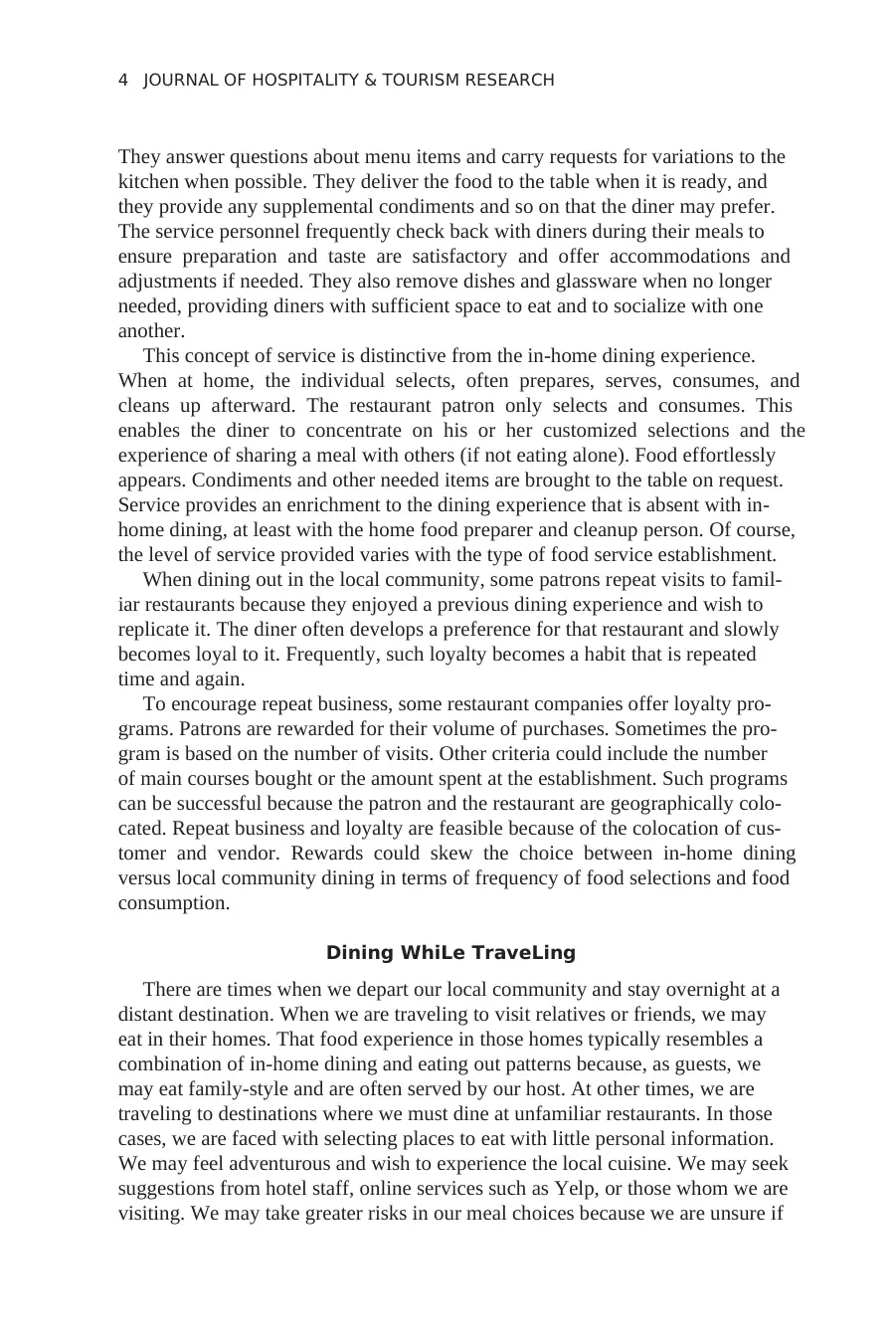
4 JOURNAL OF HOSPITALITY & TOURISM RESEARCH
They answer questions about menu items and carry requests for variations to the
kitchen when possible. They deliver the food to the table when it is ready, and
they provide any supplemental condiments and so on that the diner may prefer.
The service personnel frequently check back with diners during their meals to
ensure preparation and taste are satisfactory and offer accommodations and
adjustments if needed. They also remove dishes and glassware when no longer
needed, providing diners with sufficient space to eat and to socialize with one
another.
This concept of service is distinctive from the in-home dining experience.
When at home, the individual selects, often prepares, serves, consumes, and
cleans up afterward. The restaurant patron only selects and consumes. This
enables the diner to concentrate on his or her customized selections and the
experience of sharing a meal with others (if not eating alone). Food effortlessly
appears. Condiments and other needed items are brought to the table on request.
Service provides an enrichment to the dining experience that is absent with in-
home dining, at least with the home food preparer and cleanup person. Of course,
the level of service provided varies with the type of food service establishment.
When dining out in the local community, some patrons repeat visits to famil-
iar restaurants because they enjoyed a previous dining experience and wish to
replicate it. The diner often develops a preference for that restaurant and slowly
becomes loyal to it. Frequently, such loyalty becomes a habit that is repeated
time and again.
To encourage repeat business, some restaurant companies offer loyalty pro-
grams. Patrons are rewarded for their volume of purchases. Sometimes the pro-
gram is based on the number of visits. Other criteria could include the number
of main courses bought or the amount spent at the establishment. Such programs
can be successful because the patron and the restaurant are geographically colo-
cated. Repeat business and loyalty are feasible because of the colocation of cus-
tomer and vendor. Rewards could skew the choice between in-home dining
versus local community dining in terms of frequency of food selections and food
consumption.
Dining WhiLe TraveLing
There are times when we depart our local community and stay overnight at a
distant destination. When we are traveling to visit relatives or friends, we may
eat in their homes. That food experience in those homes typically resembles a
combination of in-home dining and eating out patterns because, as guests, we
may eat family-style and are often served by our host. At other times, we are
traveling to destinations where we must dine at unfamiliar restaurants. In those
cases, we are faced with selecting places to eat with little personal information.
We may feel adventurous and wish to experience the local cuisine. We may seek
suggestions from hotel staff, online services such as Yelp, or those whom we are
visiting. We may take greater risks in our meal choices because we are unsure if
They answer questions about menu items and carry requests for variations to the
kitchen when possible. They deliver the food to the table when it is ready, and
they provide any supplemental condiments and so on that the diner may prefer.
The service personnel frequently check back with diners during their meals to
ensure preparation and taste are satisfactory and offer accommodations and
adjustments if needed. They also remove dishes and glassware when no longer
needed, providing diners with sufficient space to eat and to socialize with one
another.
This concept of service is distinctive from the in-home dining experience.
When at home, the individual selects, often prepares, serves, consumes, and
cleans up afterward. The restaurant patron only selects and consumes. This
enables the diner to concentrate on his or her customized selections and the
experience of sharing a meal with others (if not eating alone). Food effortlessly
appears. Condiments and other needed items are brought to the table on request.
Service provides an enrichment to the dining experience that is absent with in-
home dining, at least with the home food preparer and cleanup person. Of course,
the level of service provided varies with the type of food service establishment.
When dining out in the local community, some patrons repeat visits to famil-
iar restaurants because they enjoyed a previous dining experience and wish to
replicate it. The diner often develops a preference for that restaurant and slowly
becomes loyal to it. Frequently, such loyalty becomes a habit that is repeated
time and again.
To encourage repeat business, some restaurant companies offer loyalty pro-
grams. Patrons are rewarded for their volume of purchases. Sometimes the pro-
gram is based on the number of visits. Other criteria could include the number
of main courses bought or the amount spent at the establishment. Such programs
can be successful because the patron and the restaurant are geographically colo-
cated. Repeat business and loyalty are feasible because of the colocation of cus-
tomer and vendor. Rewards could skew the choice between in-home dining
versus local community dining in terms of frequency of food selections and food
consumption.
Dining WhiLe TraveLing
There are times when we depart our local community and stay overnight at a
distant destination. When we are traveling to visit relatives or friends, we may
eat in their homes. That food experience in those homes typically resembles a
combination of in-home dining and eating out patterns because, as guests, we
may eat family-style and are often served by our host. At other times, we are
traveling to destinations where we must dine at unfamiliar restaurants. In those
cases, we are faced with selecting places to eat with little personal information.
We may feel adventurous and wish to experience the local cuisine. We may seek
suggestions from hotel staff, online services such as Yelp, or those whom we are
visiting. We may take greater risks in our meal choices because we are unsure if
Paraphrase This Document
Need a fresh take? Get an instant paraphrase of this document with our AI Paraphraser
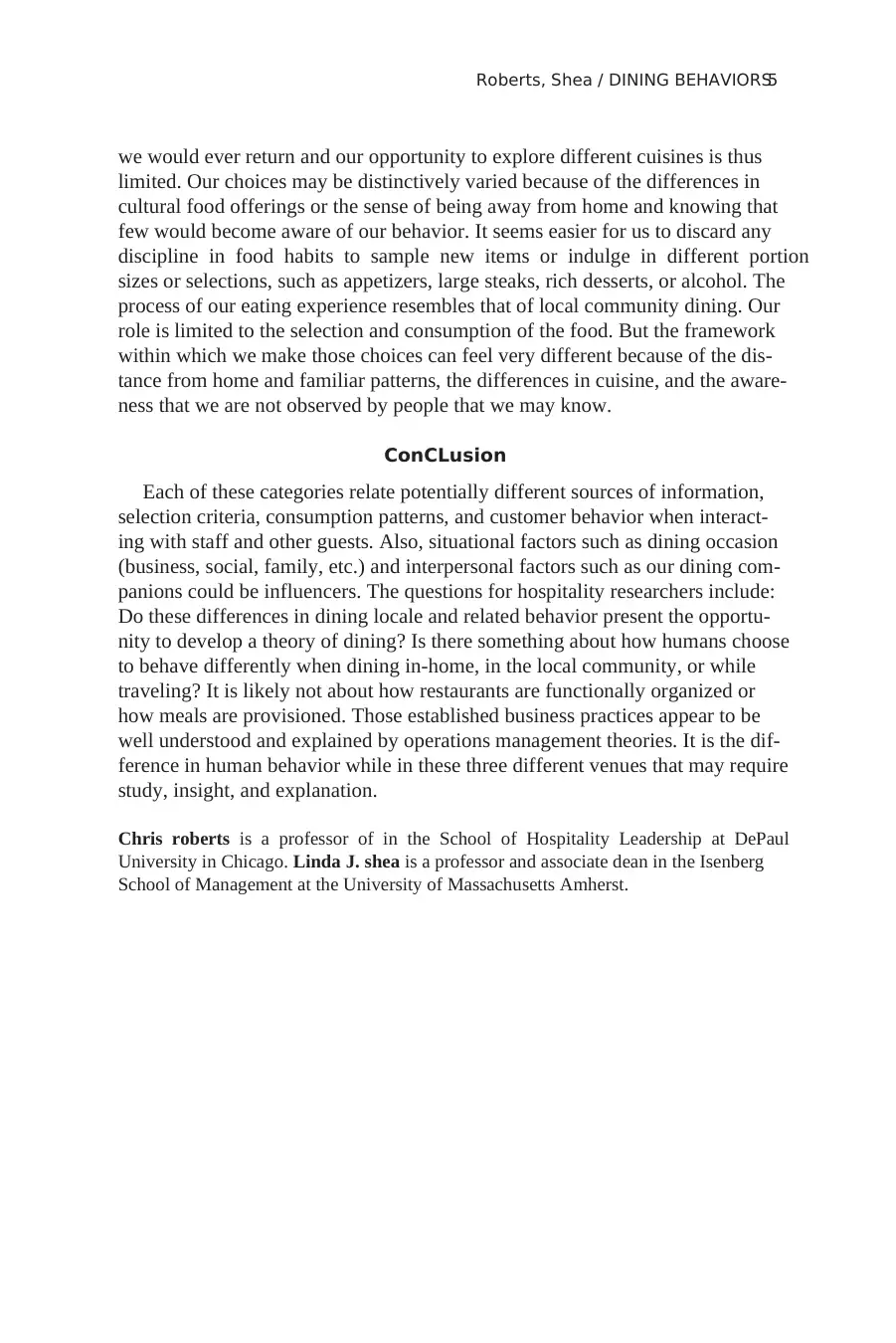
Roberts, Shea / DINING BEHAVIORS5
we would ever return and our opportunity to explore different cuisines is thus
limited. Our choices may be distinctively varied because of the differences in
cultural food offerings or the sense of being away from home and knowing that
few would become aware of our behavior. It seems easier for us to discard any
discipline in food habits to sample new items or indulge in different portion
sizes or selections, such as appetizers, large steaks, rich desserts, or alcohol. The
process of our eating experience resembles that of local community dining. Our
role is limited to the selection and consumption of the food. But the framework
within which we make those choices can feel very different because of the dis-
tance from home and familiar patterns, the differences in cuisine, and the aware-
ness that we are not observed by people that we may know.
ConCLusion
Each of these categories relate potentially different sources of information,
selection criteria, consumption patterns, and customer behavior when interact-
ing with staff and other guests. Also, situational factors such as dining occasion
(business, social, family, etc.) and interpersonal factors such as our dining com-
panions could be influencers. The questions for hospitality researchers include:
Do these differences in dining locale and related behavior present the opportu-
nity to develop a theory of dining? Is there something about how humans choose
to behave differently when dining in-home, in the local community, or while
traveling? It is likely not about how restaurants are functionally organized or
how meals are provisioned. Those established business practices appear to be
well understood and explained by operations management theories. It is the dif-
ference in human behavior while in these three different venues that may require
study, insight, and explanation.
Chris roberts is a professor of in the School of Hospitality Leadership at DePaul
University in Chicago. Linda J. shea is a professor and associate dean in the Isenberg
School of Management at the University of Massachusetts Amherst.
we would ever return and our opportunity to explore different cuisines is thus
limited. Our choices may be distinctively varied because of the differences in
cultural food offerings or the sense of being away from home and knowing that
few would become aware of our behavior. It seems easier for us to discard any
discipline in food habits to sample new items or indulge in different portion
sizes or selections, such as appetizers, large steaks, rich desserts, or alcohol. The
process of our eating experience resembles that of local community dining. Our
role is limited to the selection and consumption of the food. But the framework
within which we make those choices can feel very different because of the dis-
tance from home and familiar patterns, the differences in cuisine, and the aware-
ness that we are not observed by people that we may know.
ConCLusion
Each of these categories relate potentially different sources of information,
selection criteria, consumption patterns, and customer behavior when interact-
ing with staff and other guests. Also, situational factors such as dining occasion
(business, social, family, etc.) and interpersonal factors such as our dining com-
panions could be influencers. The questions for hospitality researchers include:
Do these differences in dining locale and related behavior present the opportu-
nity to develop a theory of dining? Is there something about how humans choose
to behave differently when dining in-home, in the local community, or while
traveling? It is likely not about how restaurants are functionally organized or
how meals are provisioned. Those established business practices appear to be
well understood and explained by operations management theories. It is the dif-
ference in human behavior while in these three different venues that may require
study, insight, and explanation.
Chris roberts is a professor of in the School of Hospitality Leadership at DePaul
University in Chicago. Linda J. shea is a professor and associate dean in the Isenberg
School of Management at the University of Massachusetts Amherst.
1 out of 5
Related Documents
Your All-in-One AI-Powered Toolkit for Academic Success.
+13062052269
info@desklib.com
Available 24*7 on WhatsApp / Email
![[object Object]](/_next/static/media/star-bottom.7253800d.svg)
Unlock your academic potential
Copyright © 2020–2025 A2Z Services. All Rights Reserved. Developed and managed by ZUCOL.




